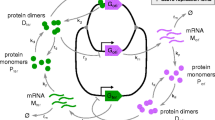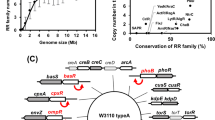Abstract
Phenotypic diversity provides populations of prokaryotic and eukaryotic organisms with the flexibility required to adapt to and/or survive environmental perturbations. Consequently, there is much interest in unraveling the molecular mechanisms of heterogeneity. A classical example of heterogeneity in Escherichia coli is the subset (3%) of the population that expresses the colicin K activity gene (cka) upon nutrient starvation. Here, we report on the mechanism underlying this variable response. As colicin synthesis is regulated by the LexA protein, the central regulator of the SOS response, we focused on the role of LexA and the SOS system in the variable cka expression. Real-time RT-PCR showed that the SOS system, without exogenous DNA damage, induces moderate levels of cka expression. The use of cka–gfp fusions demonstrated that modification of the conserved LexA boxes in the cka promoter region affected LexA binding affinity and the percentage of cka–gfp expressing cells in the population. A lexA–gfp fusion showed that the lexA gene is highly expressed in a subset of bacteria. Furthermore, cka–gfp fusions cloned into higher copy plasmid vectors increased the percentage of cka–gfp positive bacteria. Together, these results indicate that the bistability in cka expression in the bacterial population is determined by (1) basal SOS activity, (2) stochastic factors and possibly (3) the interplay of LexA dimers at cka operator. Other LexA regulated processes could exhibit similar regulation.






Similar content being viewed by others
References
Ebina Y, Takahara Y, Shirabe K, Yamada M, Nakazawa T, Nakazawa A (1983) Plasmid-encoded regulation of colicin E1 gene expression. J Bacteriol 156:487–492
Erill I, Escribano M, Campoy S, Barbé J (2003) In silico analysis reveals substantial variability in the gene contents of the gamma proteobacteria LexA-regulon. Bioinformatics 19:2225–2236
Fernández De Henestrosa AR, Ogi T, Aoyagi S, Chafin D, Hayes JJ, Ohmori H, Woodgate R (2001) Identification of additional genes belonging to the LexA regulon in Escherichia coli. Mol Microbiol 35:1560–1572
Ferrel JE Jr (2002) Self-perpetuating states in signal transduction: positive feedback, double-negative feedback and bistability. Curr Opin Cell Biol 14:140–148
Ferrel JE Jr, Machleder EM (1998) The biochemical basis of an all-or-none cell fate switch in Xenopus oocytes. Science 280:895–898
Ferrer S, Viejo M B, Guasch J F, Enfedaque J, Regue M (1996) Genetic evidence for an activator required for induction of colicin like bacteriocin 28b production in Serratia marcescens by DNA-damaging agents. J Bacteriol 178:951–960
Fraser HB, Hirsh AE, Giaver G, Kumm J, Eisen MB (2004) Noise minimization in eukaryotic gene expression. PLoS Biol 2:0834–0838
Friedberg EC, Walker GC, Siede W (1995) DNA repair and mutagenesis. American society for microbiology, Washington DC
Haijema BJ, Hahn J, Haynes J, Dubnau D (2001) A ComGA-dependent checkpoint limits growth during the escape from competence. Mol Microbiol 40:52–64
Hernday A, Braaten BA, Low D (2003) The mechanism by which DNA adenine methylase and PapI activate the pap epigenetic switch. Mol Cell 12:947–957
Jerman B, Butala M, Žgur-Bertok D (2005) Sublethal concentrations of ciprofloxacin induce bacteriocin synthesis in Escherichia coli. Antimicrob Agents Chemother 49:3087–3090
Kirkup BC, Riley MA (2004) Antibiotic mediated antagonism leads to a bacterial game of rock-paper-scissors in vivo. Nature 428:412–414
Kuhar I, Žgur-Bertok D (1999) Transcription regulation of the colicin K cka gene reveals induction of colicin synthesis by differential responses to environmental signals. J Bacteriol 181:7373–7380
Kuhar I, van Putten JP, Žgur-Bertok D, Gaastra W, Jordi BJ (2001) Codon-usage based regulation of colicin K synthesis by the stress alarmone ppGpp. Mol Microbiol 41:207–216
Lewis KL, Harlow GR, Gregg-Jolly LA, Mount DW (1994) Identification of high affinity binding sites for LexA which define new DNA damage-inducible genes in Escherichia coli. J Mol Biol 241:507–523
Livak KJ, Schmittgen TD (2001) Analysis of relative gene expression data using real-time quantitative PCR and the 2 −ΔΔC T method. Methods 25:402–408
Lloubes R, Granger-Schnarr M, Lazdunski C, Schnarr M (1991) Interaction of a regulatory protein with a DNA target containing two overlapping binding sites. J Biol Chem 266:2303–2312
Lu FM, Chak KF (1996) Two overlapping SOS-boxes in ColE operons are responsible for the viability of cells harboring the Col plasmid. Mol Gen Genet 251:407–411
Maamer H, Dubnau D (2005) Bistability in the Bacillus subtilis K-state (competence) system requires a positive feedback loop. Mol Microbiol 56:615–624
McAdams HH, Arkin A (1999) It’s a noisy business. Genetic regulation at the nanomolar scale. Trends Genet 15:65–69
Michael SF (1994) Mutagenesis by incorporation of a phosphorylated oligo during PCR amplification. BioTechniques 16:409–412
Michel-Briand Y, Baysee C (2002) The pyocins of Pseudomonas aeruginosa. Biochimie 84:499–510
Miller JH (1972) Experiments in molecular genetics. Cold Spring Harbor Laboratory, Cold Spring Harbor
Mulec J, Podlesek Z, Mrak P, Kopitar A, Ihan A, Žgur-Bertok D (2003) A cka–gfp transcriptional fusion reveals that the colicin K activity gene is induced in only 3 percent of the population. J Bacteriol 185:654–659
Novick A, Weiner M (1957) Enzyme induction as an all-or-none phenomenon. Proc Natl Acad Sci USA 43:553–567
Ozbudak EM, Thattai M, Kurster I, Grossman AD, van Oudenaarden A (2002) Regulation of noise in the expression of a single cell. Nat Genet 31:69–73
Pilsl H, Braun V (1995) Strong function-related homology between the pore-forming colicins K and 5. J Bacteriol 177:6973–6977
Riley MA, Wertz JE (2002) Bacteriocins: evolution, ecology and application. Annu Rev Microbiol 56:117–137
Riley MA, Pinou T, Wertz JE, Tan Y, Valletta CM (2001) Molecular characterization of the klebicin b plasmid of Klebsiella pneumoniae. Plasmid 45:209–221
Ronen M, Rosenberg R, Shraiman BI, Alon U (2002) Assigning numbers to the arrows: parametrizing a gene regulation network by accurate expression kinetics. Proc Natl Acad Sci USA 99:10555–10560
Salles B, Weisemann JM, Weinstock GM (1987) Temporal control of colicin E1 induction. J Bacteriol 169:5028–5034
Sambrook J, Fritsch EF, Maniatis T (1989) Molecular cloning: a laboratory manual, 2nd edn. Cold Spring Harbor Laboratory, Cold Spring Harbor
Schneider K, Beck CF (1986) Promoter-probe vectors for the analysis of divergently arranged promoters. Gene 42:37–48
Sonenshein AL (2000) Control of sporulation initiation in Bacillus subtilis. Curr Opin Microbiol 3:561–566
Suarez A, Güttller A, Strätz M, Staendner LH, Timmis KN, Guzmán CA (1997) Green fluorescent protein-based reporter system for genetic analysis of bacteria including monocopy applications. Gene 196:69–74
Thattai M, van Oudenaarden A (2004) Stochastic gene expression in fluctuating environments. Genetics 167:523–530
Wertman KF, Mount DW (1985) Nucleotide sequence binding specificity of the LexA repressor of Escherichia coli K-12. J Bacteriol 163:376–384
Wertz JE, Riley MA (2004) Chimeric nature of two plasmids of Hafnia alvei encoding the bacteriocins alveicins A and B. J Bacteriol 186:1598–1605
Acknowledgments
We thank Roger Woodgate for generously providing strains RW118 and RW464 as well as the LexA protein and Uri Alon for strain AB1157 carrying the lexA–gfp fusion. Irena Kuhar and John Little are acknowledged for insightful comments. This work was supported by grant P0-0508-0487 from the Slovene Ministry of Higher Education and Science.
Author information
Authors and Affiliations
Corresponding author
Additional information
Communicated by D. Andersson.
Rights and permissions
About this article
Cite this article
Mrak, P., Podlesek, Z., van Putten, J.P.M. et al. Heterogeneity in expression of the Escherichia coli colicin K activity gene cka is controlled by the SOS system and stochastic factors. Mol Genet Genomics 277, 391–401 (2007). https://doi.org/10.1007/s00438-006-0185-x
Received:
Accepted:
Published:
Issue Date:
DOI: https://doi.org/10.1007/s00438-006-0185-x




